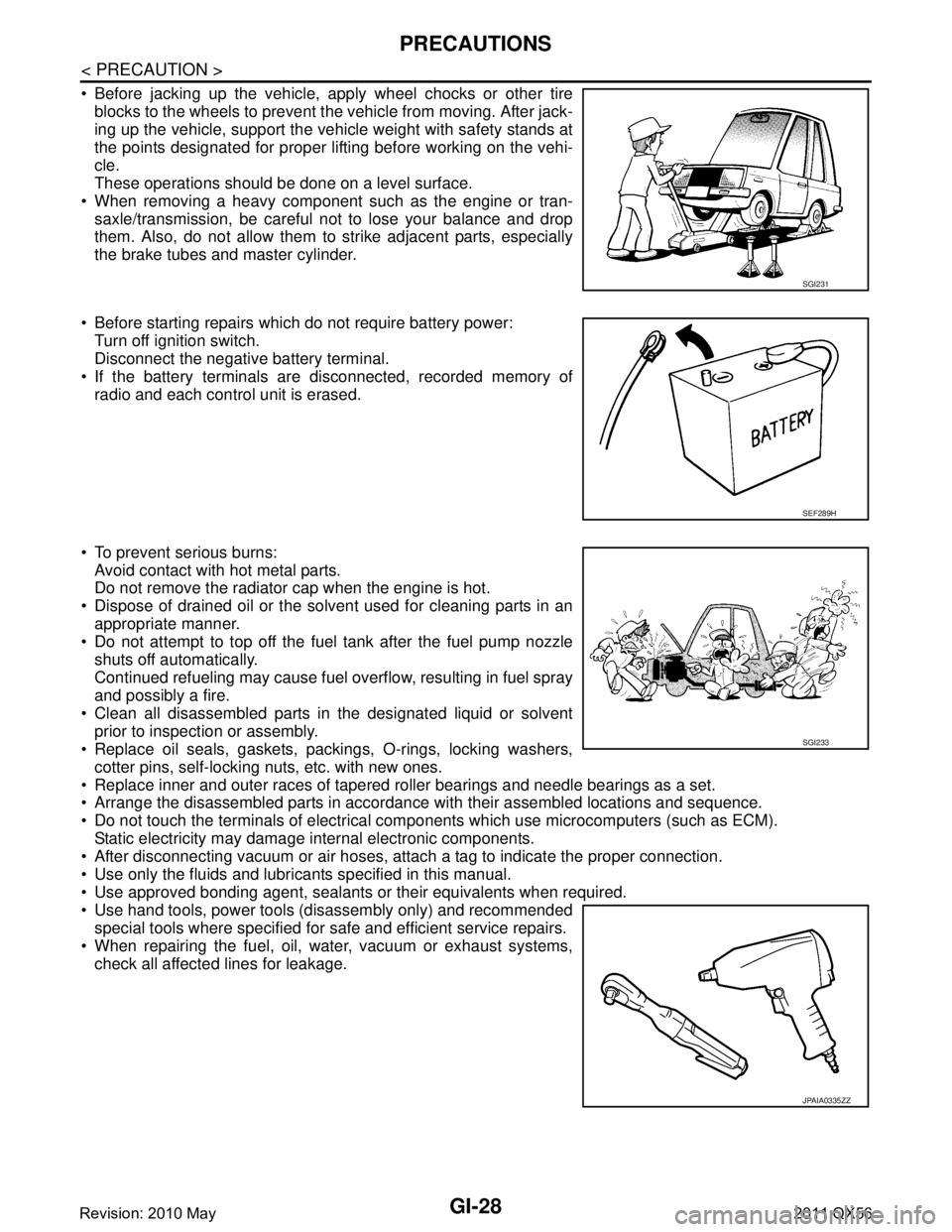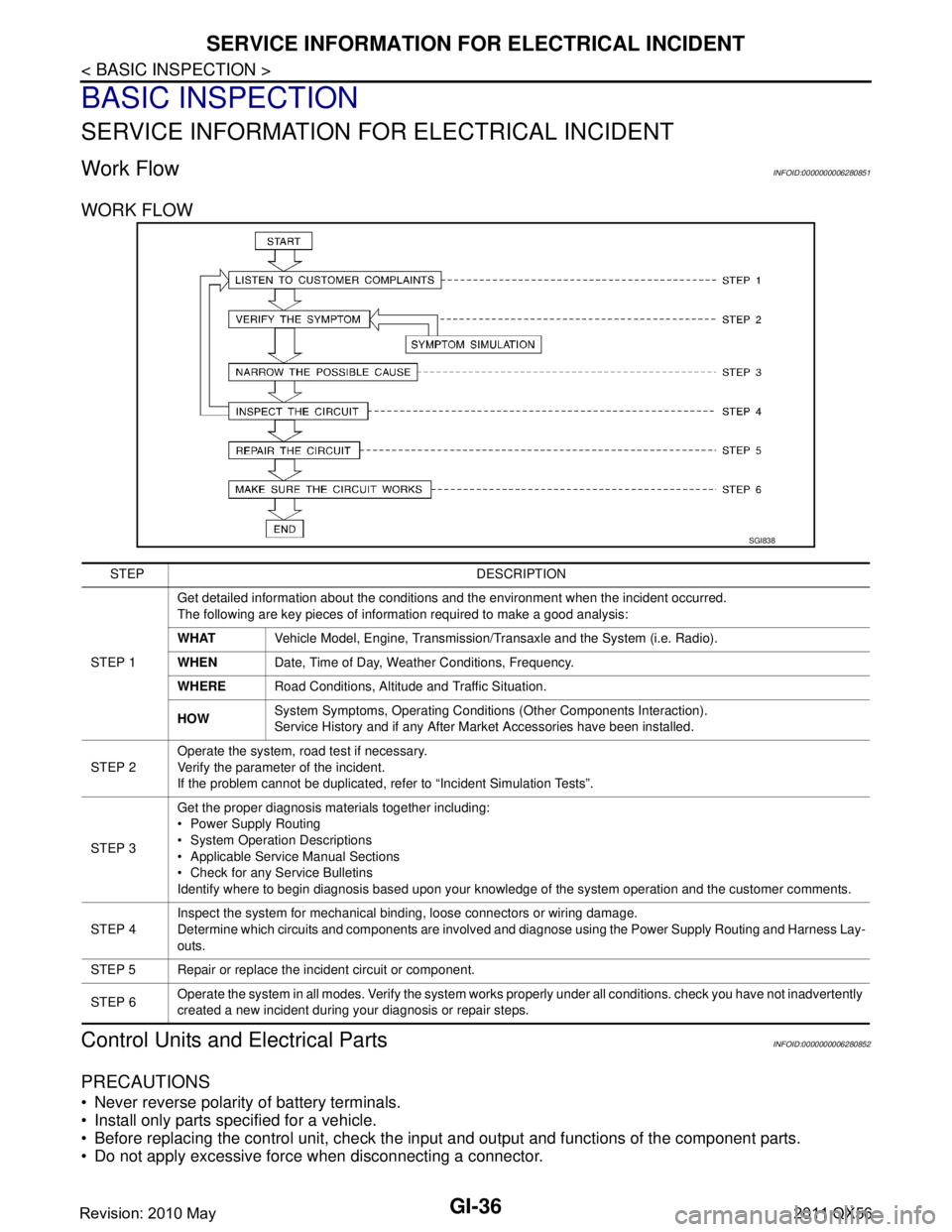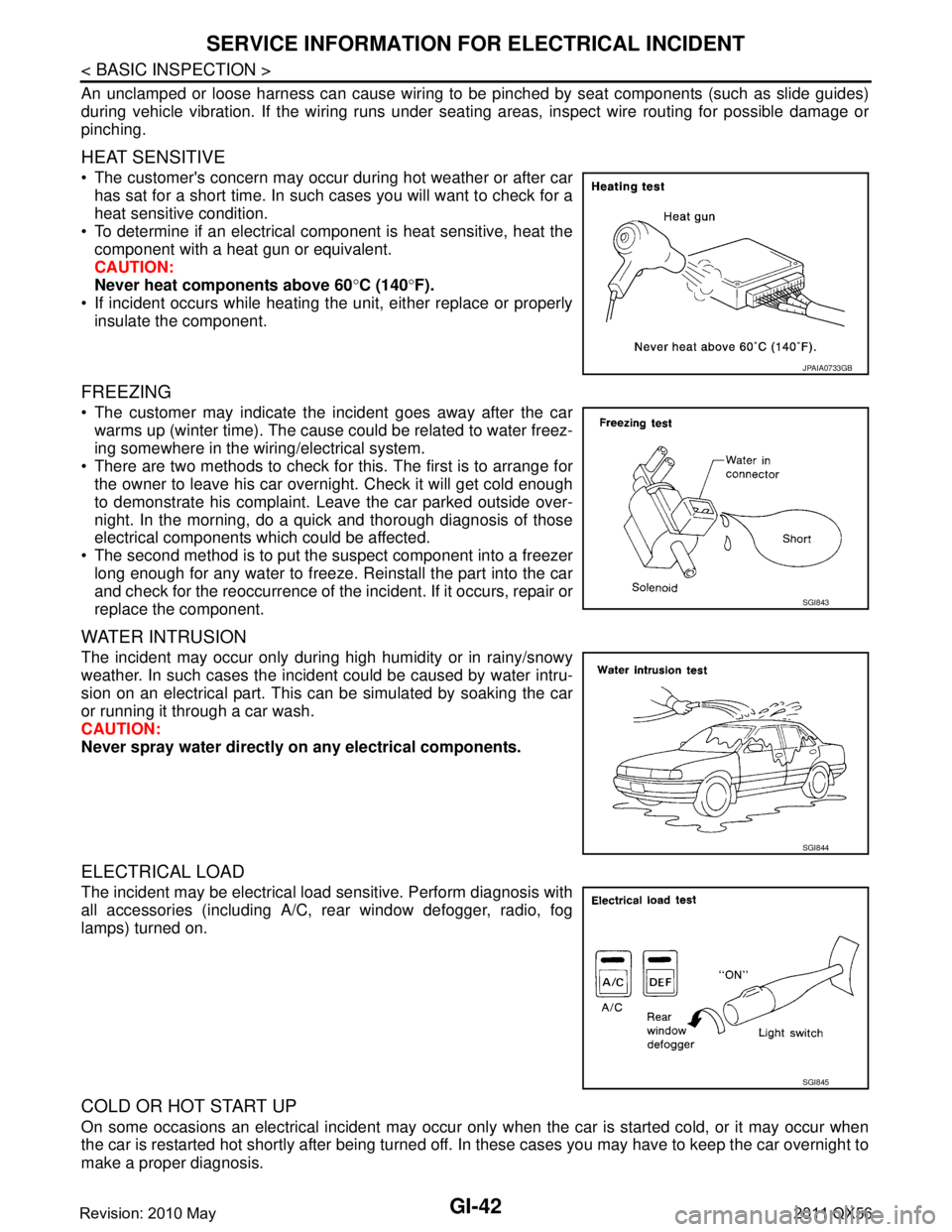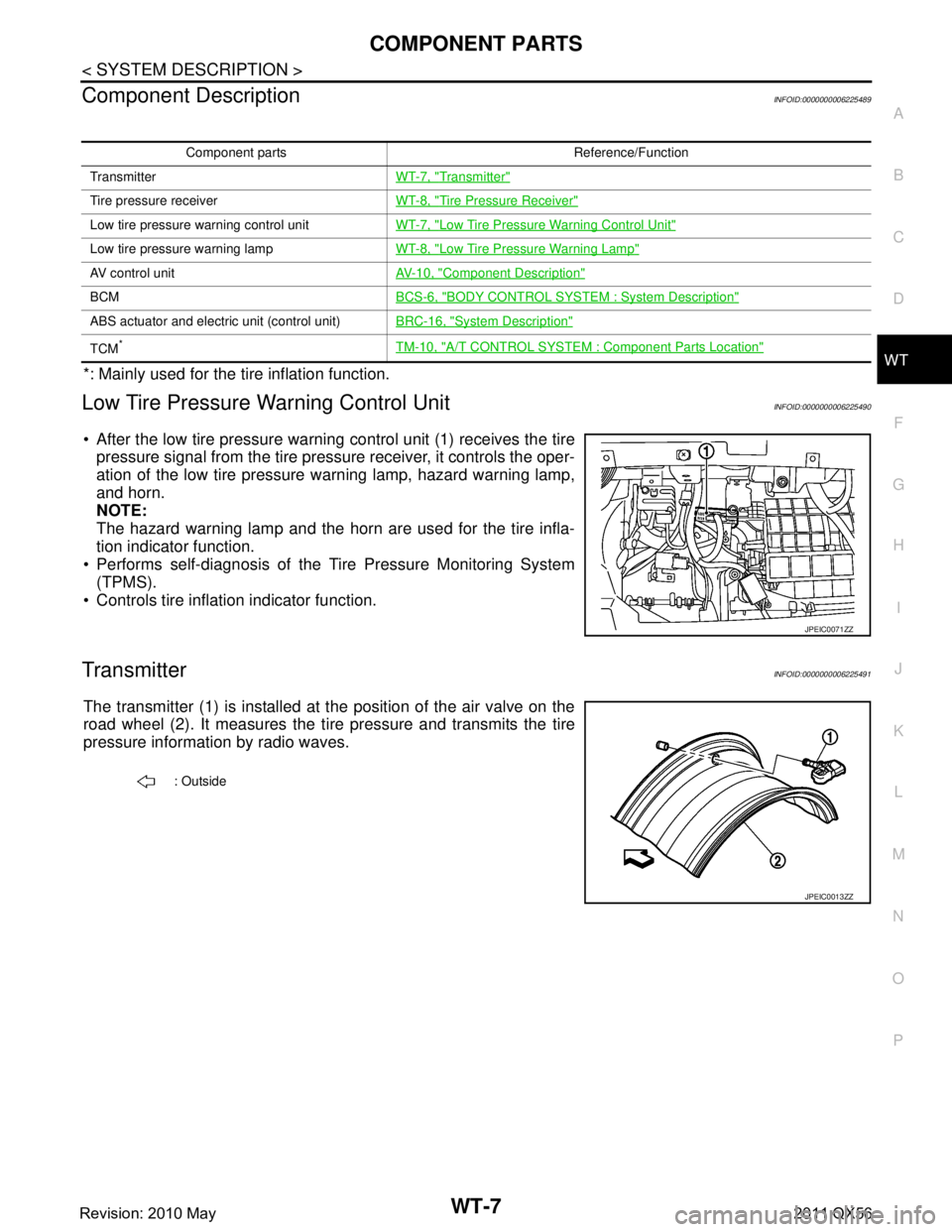Page 1573 of 5598
SYSTEM (INTEGRATED HOMELINK TRANSMITTER)DLK-37
< SYSTEM DESCRIPTION >
C
DE
F
G H
I
J
L
M A
B
DLK
N
O P
SYSTEM (INTEGRATED HO MELINK TRANSMITTER)
System DescriptionINFOID:0000000006256146
Item Function
Integrated homelink transmitter A maximum of 3 radio signals can be stored and transmitted to operate the garage door, etc.
Revision: 2010 May2011 QX56
Page 2037 of 5598
PRECAUTIONSEC-13
< PRECAUTION > [VK56VD]
C
D
E
F
G H
I
J
K L
M A
EC
NP
O
When installing C.B. ham radio or a mobile phone, be sure to
observe the following as it may adversely affect electronic
control systems depending on installation location.
- Keep the antenna as far as possi ble from the electronic con-
trol units.
- Keep the antenna feeder line more than 20 cm (8 in) away
from the harness of electronic controls.
Never let them run parallel for a long distance.
- Adjust the antenna and feeder line so that the standing-wave
ratio can be kept smaller.
- Be sure to ground the radio to vehicle body.
SEF708Y
Revision: 2010 May2011 QX56
Page 2992 of 5598

GI-28
< PRECAUTION >
PRECAUTIONS
Before jacking up the vehicle, apply wheel chocks or other tireblocks to the wheels to prevent t he vehicle from moving. After jack-
ing up the vehicle, support the vehicle weight with safety stands at
the points designated for proper lifting before working on the vehi-
cle.
These operations should be done on a level surface.
When removing a heavy component such as the engine or tran- saxle/transmission, be careful not to lose your balance and drop
them. Also, do not allow them to strike adjacent parts, especially
the brake tubes and master cylinder.
Before starting repairs which do not require battery power: Turn off ignition switch.
Disconnect the negative battery terminal.
If the battery terminals are disconnected, recorded memory of
radio and each control unit is erased.
To prevent serious burns: Avoid contact with hot metal parts.
Do not remove the radiator cap when the engine is hot.
Dispose of drained oil or the solvent used for cleaning parts in an appropriate manner.
Do not attempt to top off the fuel tank after the fuel pump nozzle
shuts off automatically.
Continued refueling may cause fuel overflow, resulting in fuel spray
and possibly a fire.
Clean all disassembled parts in the designated liquid or solvent prior to inspection or assembly.
Replace oil seals, gaskets, packings, O-rings, locking washers,
cotter pins, self-locking nuts, etc. with new ones.
Replace inner and outer races of tapered roller bearings and needle bearings as a set.
Arrange the disassembled parts in accordance with their assembled locations and sequence.
Do not touch the terminals of electrical com ponents which use microcomputers (such as ECM).
Static electricity may damage internal electronic components.
After disconnecting vacuum or air hoses, atta ch a tag to indicate the proper connection.
Use only the fluids and lubricants specified in this manual.
Use approved bonding agent, sealants or their equivalents when required.
Use hand tools, power tools (disassembly only) and recommended special tools where specified for safe and efficient service repairs.
When repairing the fuel, oil, water, vacuum or exhaust systems, check all affected lines for leakage.
SGI231
SEF289H
SGI233
JPAIA0335ZZ
Revision: 2010 May2011 QX56
Page 3000 of 5598

GI-36
< BASIC INSPECTION >
SERVICE INFORMATION FOR ELECTRICAL INCIDENT
BASIC INSPECTION
SERVICE INFORMATION FOR ELECTRICAL INCIDENT
Work FlowINFOID:0000000006280851
WORK FLOW
Control Units and Electrical PartsINFOID:0000000006280852
PRECAUTIONS
Never reverse polarity of battery terminals.
Install only parts specified for a vehicle.
Before replacing the control unit, check the i nput and output and functions of the component parts.
Do not apply excessive force when disconnecting a connector.
SGI838
STEP DESCRIPTION
STEP 1 Get detailed information about the conditions and the environment when the incident occurred.
The following are key pieces of information required to make a good analysis:
WHAT
Vehicle Model, Engine, Transmission/Transaxle and the System (i.e. Radio).
WHEN Date, Time of Day, Weather Conditions, Frequency.
WHERE Road Conditions, Altitude and Traffic Situation.
HOW System Symptoms, Operating Conditions
(Other Components Interaction).
Service History and if any After Market Accessories have been installed.
STEP 2 Operate the system, road test if necessary.
Verify the parameter of the incident.
If the problem cannot be duplicated, refer to “Incident Simulation Tests”.
STEP 3 Get the proper diagnosis materials together including:
Power Supply Routing
System Operation Descriptions
Applicable Service Manual Sections
Check for any Service Bulletins
Identify where to begin diagnosis based upon your knowledge of the system operation and the customer comments.
STEP 4 Inspect the system for mechanical binding, loose connectors or wiring damage.
Determine which circuits and components are involved and diagnose using the Power Supply Routing and Harness Lay-
outs.
STEP 5 Repair or replace the incident circuit or component.
STEP 6 Operate the system in all modes. Verify the system works properly under all conditions. check you have not inadvertently
created a new incident during your diagnosis or repair steps.
Revision: 2010 May2011 QX56
Page 3006 of 5598

GI-42
< BASIC INSPECTION >
SERVICE INFORMATION FOR ELECTRICAL INCIDENT
An unclamped or loose harness can cause wiring to be pinched by seat components (such as slide guides)
during vehicle vibration. If the wiring runs under s eating areas, inspect wire routing for possible damage or
pinching.
HEAT SENSITIVE
The customer's concern may occur during hot weather or after car has sat for a short time. In such cases you will want to check for a
heat sensitive condition.
To determine if an electrical component is heat sensitive, heat the component with a heat gun or equivalent.
CAUTION:
Never heat components above 60 °C (140 °F).
If incident occurs while heating the unit, either replace or properly insulate the component.
FREEZING
The customer may indicate the incident goes away after the carwarms up (winter time). The cause could be related to water freez-
ing somewhere in the wiring/electrical system.
There are two methods to check for this. The first is to arrange for the owner to leave his car overnight. Check it will get cold enough
to demonstrate his complaint. Leave the car parked outside over-
night. In the morning, do a quick and thorough diagnosis of those
electrical components which could be affected.
The second method is to put the suspect component into a freezer long enough for any water to freeze. Reinstall the part into the car
and check for the reoccurrence of the incident. If it occurs, repair or
replace the component.
WATER INTRUSION
The incident may occur only during high humidity or in rainy/snowy
weather. In such cases the incident could be caused by water intru-
sion on an electrical part. This can be simulated by soaking the car
or running it through a car wash.
CAUTION:
Never spray water directly on any electrical components.
ELECTRICAL LOAD
The incident may be electrical load sensitive. Perform diagnosis with
all accessories (including A/C, rear window defogger, radio, fog
lamps) turned on.
COLD OR HOT START UP
On some occasions an electrical incident may occur only when the car is started cold, or it may occur when
the car is restarted hot shortly after being turned off. In these cases you may have to keep the car overnight to
make a proper diagnosis.
JPAIA0733GB
SGI843
SGI844
SGI845
Revision: 2010 May2011 QX56
Page 4192 of 5598
PWO
NORMAL OPERATING CONDITIONPWO-33
< SYMPTOM DIAGNOSIS > [AC 120 V OUTLET]
C
D
E
F
G H
I
J
K L
B A
O P
N
NORMAL OPERATING CONDITION
DescriptionINFOID:0000000006257122
Because of modified sine wave output, the AC 120 V out
let may not operate normally for electric appliance of
which electric power consumption is 150 W or less.
Electric appliances requiring a large amount of electr ic power consumption at startup (e.g. CRT-based TV,
power tool)
Measuring instruments for data requiring accuracy (e.g. medical equipment, measuring instrument)
Microprocessor-controlled appliances (e.g. microprocessor-controlled blanket)
Noise may be caused in radio or TV, depending on an electric appliance.
Revision: 2010 May2011 QX56
Page 5457 of 5598

COMPONENT PARTSWT-7
< SYSTEM DESCRIPTION >
C
DF
G H
I
J
K L
M A
B
WT
N
O P
Component DescriptionINFOID:0000000006225489
*: Mainly used for the tire inflation function.
Low Tire Pressure Warning Control UnitINFOID:0000000006225490
After the low tire pressure warning control unit (1) receives the tire pressure signal from the tire pressure receiver, it controls the oper-
ation of the low tire pressure warning lamp, hazard warning lamp,
and horn.
NOTE:
The hazard warning lamp and the horn are used for the tire infla-
tion indicator function.
Performs self-diagnosis of the Tire Pressure Monitoring System
(TPMS).
Controls tire inflation indicator function.
TransmitterINFOID:0000000006225491
The transmitter (1) is installed at the position of the air valve on the
road wheel (2). It measures the ti re pressure and transmits the tire
pressure information by radio waves.
Component parts Reference/Function
Transmitter WT-7, "
Transmitter"
Tire pressure receiverWT-8, "Tire Pressure Receiver"
Low tire pressure warning control unit WT-7, "Low Tire Pressure Warning Control Unit"
Low tire pressure warning lamp WT-8, "Low Tire Pressure Warning Lamp"
AV control unit AV- 1 0 , "Component Description"
BCMBCS-6, "BODY CONTROL SYSTEM : System Description"
ABS actuator and electric unit (control unit)BRC-16, "System Description"
TCM*TM-10, "A/T CONTROL SYSTEM : Component Parts Location"
JPEIC0071ZZ
: Outside
JPEIC0013ZZ
Revision: 2010 May2011 QX56
Page 5458 of 5598
WT-8
< SYSTEM DESCRIPTION >
COMPONENT PARTS
Tire Pressure Receiver
INFOID:0000000006225492
The front tire pressure receiver (1) and rear tire pressure receiver (2)
receive the tire pressure signal by radio waves from the transmitter
at each wheel, and transmit the tire pressure signal to the low tire
pressure warning control unit.
Low Tire Pressure Warning LampINFOID:0000000006225493
Uses CAN communication from the low tire pressure warning control
unit to illuminate the low tire pressure warning lamp on the combina-
tion meter.
*: Tire pressure at each condition differs. A: Front side
B : Rear side
JPEIC0070ZZ
NNEIC0001ZZ
Condition Low tire pr
essure warning lamp
Ignition switch: OFF OFF
Ignition switch: ON Warning lamp turns on for 1second, then turns OFF.
When tire pressure is low*.
[Less than 189 kPa (1.93 kg/cm
2, 27.4 psi)] ON
Tire pressure monitoring system malfunction Warning lamp blinks 1 minute, then turns ON.
Revision: 2010 May2011 QX56